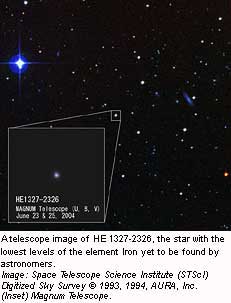|
Summary -
(Apr 14, 2005) Astronomers from
the Australian National University think they've
found one of the earliest stars to have formed
in the Universe. It's called HE 1327-2326, and
it has the lowest levels of iron ever found in
any star. Heavier elements like iron only form
inside stars, so HE 1327-2326 could have formed
before successive generations of stars had
seeded the Universe. This star was observed
using the Japanese Subaru 8-m telescope, and
found to be twice as iron poor as the previous
record holder.
Full Story -
|
 |
|
Image
credit: ANU |
A new star that
may be one of the first to have formed in the
Universe has been discovered by an international
team led by ANU researchers.
The new star — which goes by the innocuous name
HE 1327-2326 — is of enormous importance because
it provides the crucial evidence of the time
when the very first stars formed after the Big
Bang.
“This star’s a record breaker — it has the
lowest levels of iron ever recorded in a star so
far. This is of great importance because it
indicates HE 1327-2326 formed in the very early
Universe,” team leader and astronomy PhD
student, Ms Anna Frebel said.
In general, stars with a low iron abundance
compared to the Earth’s sun are called
‘metal-poor’ stars.
“Elements such as iron are only synthesised in
the course of the lifetime of stars during the
evolution of the Universe,” Ms Frebel said.
“Thus, we believe HE 1327-2326 formed shortly
after the Big Bang — it’s about twice as
iron-poor as the previous record holder, HE
0107-5240, which was discovered in 2001 by ANU
and German astronomers as part of the same
survey.
“HE 1327-2326 will be used to trace the very
early chemical enrichment history of the
Universe as well as star formation processes and
will challenge astronomers around the world —
it’s a pretty exciting prospect.”
The researchers first observed HE 1327-2326
using the European Southern Observatory’s
3.6-metre telescope in Chile. High quality data
taken later with Japan’s 8-metre Subaru
telescope in Hawaii revealed HE 1327-2326’s
extraordinarily low iron content.
The star was discovered in a sample of about
1800 ‘metal-poor’ stars that are being
investigated as part of Ms Frebel’s PhD project
and is detailed in the latest edition of Nature
in the paper Nucleosynthetic signatures of the
first stars.
Research collaborators included Professor John
Norris from the Research School of Astronomy and
Astrophysics, Dr Wako Aoki from the National
Astronomical Observatories of Japan and Dr
Norbert Christlieb from Hamburger Sternwarte in
Germany, as well as other researchers in Sweden,
the US, the UK, Japan and Australia.
“HE 1327-2326 is a very unusual object in many
ways for us astronomers,” Professor Norris, Ms
Frebel’s supervisor, said. “Relative to its iron
levels has abnormally high levels of several
elements including carbon, nitrogen and
strontium.
“Another very interesting and unusual
observation is that no lithium could be detected
in the relatively unevolved star. A yet unknown
process must have led to depletion of that
element.
“Stars that formed later in the history of the
Universe tend to have more predictable ratios of
these elements,” Professor Norris said.
Ms Frebel said there could be several scenarios
that explain the unusual features of HE
1327-2326.
“An explanation could be that only one explosion
of one of the first stars in the Universe
happened, which led to pollution of the
surrounding gas cloud with elements heavier than
hydrogen, helium and lithium in which stars like
HE 1327-2326 might have formed,” she said.
“However, it can not be excluded that HE
1327-2326 formed just after the Big Bang and
there was little time for the iron content to
develop and therefore is actually one of the
‘first stars’ itself — although as yet no
genuine ‘first star’ has been found.”
Original Source: ANU
News Release
|


